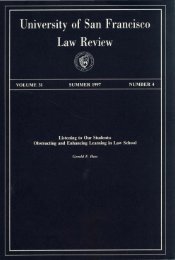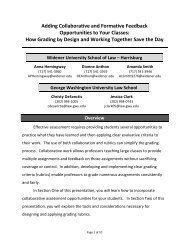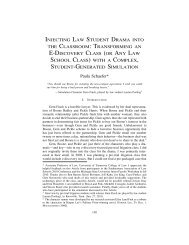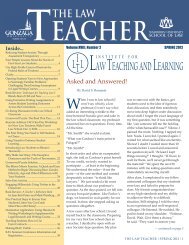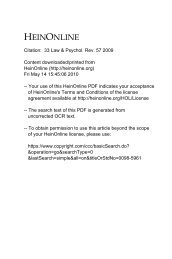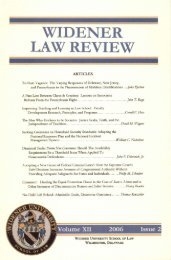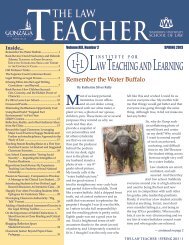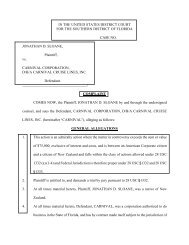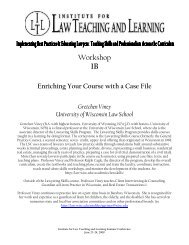Teaching the Law School Curriculum - Institute for Law Teaching ...
Teaching the Law School Curriculum - Institute for Law Teaching ...
Teaching the Law School Curriculum - Institute for Law Teaching ...
You also want an ePaper? Increase the reach of your titles
YUMPU automatically turns print PDFs into web optimized ePapers that Google loves.
Business Associations 11<br />
<strong>the</strong> student with <strong>the</strong> money some basic questions like “What are you going to do with <strong>the</strong> money?” and “Are you<br />
worried about anything as you sit <strong>the</strong>re with $100,000?” Eventually I get <strong>the</strong> students to see <strong>the</strong> interplay of Klein<br />
and Coffee’s four “deal points” — risk, return, control, and duration. As <strong>the</strong> class develops, I have <strong>the</strong> “money”<br />
student and <strong>the</strong> “skills” student shake hands and go into business selling futons to college kids. The money student<br />
contributes <strong>the</strong> $100,000 in exchange <strong>for</strong> half of <strong>the</strong> profits, and <strong>the</strong> skills student contributes hard work<br />
and genius <strong>for</strong> <strong>the</strong> o<strong>the</strong>r half. After this simple handshake, we proceed to discuss what kind of business association<br />
has been <strong>for</strong>med. This is a nice introduction to <strong>the</strong> indeterminacy of some business association doctrines. I<br />
keep <strong>the</strong> hypo vague in important particulars — so <strong>the</strong> two may have <strong>for</strong>med a partnership, or a sole proprietorship<br />
where <strong>the</strong> skills student has borrowed <strong>the</strong> money, or a sole proprietorship where <strong>the</strong> money student has<br />
hired <strong>the</strong> o<strong>the</strong>r as a manager.<br />
I started using this hypo when I first taught <strong>the</strong> course and used <strong>the</strong> Hamilton book, which starts with a similar<br />
hypo. While I am not currently using <strong>the</strong> Hamilton materials, I still use <strong>the</strong> furniture store hypo because it<br />
is quite homey and easy <strong>for</strong> <strong>the</strong> students to get a handle on. I return to <strong>the</strong> furniture store hypo throughout <strong>the</strong><br />
course as different areas of corporations doctrine are covered.<br />
I do this <strong>for</strong> a couple of reasons. First it is fun. Using props like <strong>the</strong> wad of fake bills and <strong>the</strong> phony diploma<br />
on <strong>the</strong> first day breaks <strong>the</strong> ice nicely and makes students open to <strong>the</strong> idea that <strong>the</strong> course might be enjoyable. Second,<br />
asking <strong>the</strong> two students a series of questions about what <strong>the</strong>y want to get out of <strong>the</strong> deal in terms of economic<br />
and non-economic payoffs, and <strong>the</strong> worries <strong>the</strong>y have about <strong>the</strong> business <strong>the</strong>y are about <strong>the</strong> embark upon,<br />
gives <strong>the</strong>m some com<strong>for</strong>t that <strong>the</strong>y have at least an intuitive grasp of important business ideas.<br />
Eric Gouvin, Western New England College <strong>School</strong> of <strong>Law</strong><br />
For a number of years, I have introduced <strong>the</strong> course with a newspaper article that chronicles a legal battle over<br />
a local brew pub. The students’ familiarity with <strong>the</strong> establishment and <strong>the</strong> article’s coverage of several issues discussed<br />
in <strong>the</strong> course make it a more effective way to stimulate discussion than a faceless hypo<strong>the</strong>tical.<br />
The article profiles a closely held business in which <strong>the</strong>re is a falling out between two of <strong>the</strong> founders (who<br />
are bro<strong>the</strong>rs) and <strong>the</strong> third founder. The author of <strong>the</strong> article inadvertently creates a wonderful point of entry by<br />
referring to <strong>the</strong> business at one point as a partnership and elsewhere as a shareholder’s agreement. I begin <strong>the</strong><br />
discussion by asking whe<strong>the</strong>r it matters if <strong>the</strong> business is a partnership or a corporation, which naturally leads<br />
into a treatment of <strong>the</strong> legal differences between <strong>the</strong> two. The problems among <strong>the</strong> partners involve fairly classic<br />
examples of management disagreements and <strong>the</strong> Meinhard v. Salmon type of fiduciary duty issues.<br />
Eric Lustig, New England <strong>School</strong> of <strong>Law</strong><br />
I occasionally use props in class. One role-playing exercise was a class business making footballs. So, I brought<br />
in a big, lea<strong>the</strong>r UT football. I <strong>the</strong>n wrote all over <strong>the</strong> football <strong>the</strong> ideas students had raised in class about entity<br />
characteristics (in <strong>the</strong> <strong>for</strong>m of <strong>the</strong> participants’ needs and wants in founding <strong>the</strong> business enterprise) and brought<br />
it back to class periodically over <strong>the</strong> term when it became relevant to <strong>the</strong> class discussion.<br />
Joan Heminway, The University of Tennessee College of <strong>Law</strong><br />
On <strong>the</strong> first day of class I introduce students to <strong>the</strong> corporations course by explaining <strong>the</strong> syllabus, assignments,<br />
preparation and participation requirements, exam, and my methodology <strong>for</strong> covering <strong>the</strong> course materials.<br />
Afterwards, I distribute a short set of corporate bylaws. I instruct <strong>the</strong> class to close <strong>the</strong>ir books, set down <strong>the</strong>ir<br />
pencils, and read <strong>the</strong> bylaws. A few minutes later I ask <strong>the</strong>m what <strong>the</strong>y thought. The usual response is that <strong>the</strong><br />
bylaws are unintelligible and indigestible. I assure <strong>the</strong>m that although <strong>the</strong> bylaws are incomprehensible today, by<br />
<strong>the</strong> end of <strong>the</strong> course <strong>the</strong>y will understand every word and concept contained in <strong>the</strong>m. I <strong>the</strong>n suggest that an excellent<br />
measure of how much <strong>the</strong>y have learned in <strong>the</strong> course is to reread <strong>the</strong> bylaws be<strong>for</strong>e <strong>the</strong>y begin to study





